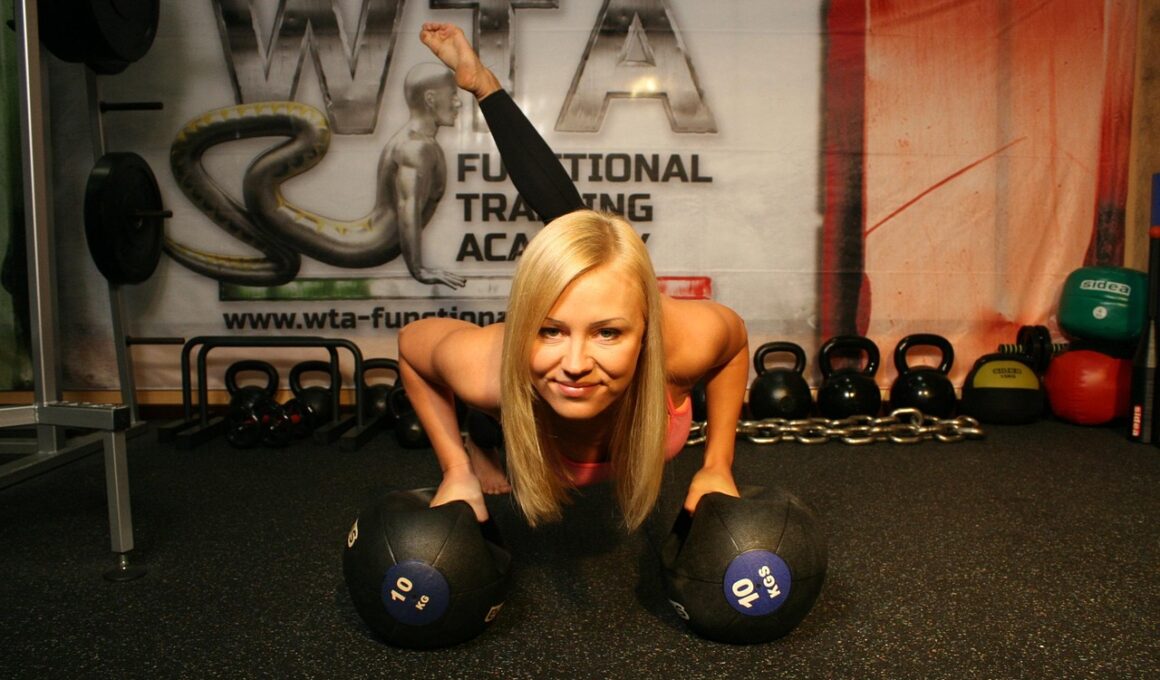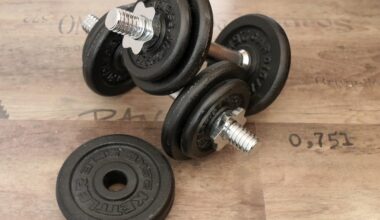How to Maintain Mobility Gains When Training CrossFit Several Times a Week
For CrossFit athletes, maintaining mobility while training multiple times a week is essential to prevent injuries and enhance performance. Mobility routines should be designed to promote flexibility and recovery, targeting muscle groups used intensely during workouts. Consistent practice of dynamic stretching aids in improving range of motion significantly. Incorporating mobility work post-workout would ensure that the body stays limber. Before each WOD, athletes can perform targeted warm-ups to prepare joints and muscles. An excellent method is to incorporate sport-specific drills that prepare the body for tasks at hand. This also keeps the body engaged and ready for high-intensity exercises. Exercises like hip openers, ankle mobility drills, and thoracic rotations should become staples in your routine. They can enhance your overall stability and strength, which is crucial for weightlifting and more complex movements. To experience lasting results, consistency is key. Establish a routine and stick to it, even adding variations in mobility area each week. This not only assists in progress but keeps workouts exciting and engaging. Developing a mobility-focused mindset creates a culture of longevity in training.
Including proper recovery days is vital for athletes focused on maintaining their mobility gains. These designated days should incorporate active recovery tactics like light yoga, swimming, or mobility-focused workouts. Low-impact activities ensure the body receives adequate rest while still engaging muscles. Focusing on recovery encourages muscle repair and joint maintenance without imposing stress. In addition to these activities, nutrition plays an essential role in such routines. Consuming a balanced diet rich in anti-inflammatory foods will aid recovery, helping athletes maintain their flexibility. Hydration also contributes significantly to physical performance. Drinking enough water ensures muscle elasticity and helps to prevent cramping. Another crucial aspect is foam rolling; this self-myofascial release technique targets tight spots to alleviate tension and release knots. Investing time in regular foam rolling can significantly reduce stiffness. Combining foam rolling with thorough stretching can improve overall results, especially when it comes to joint and muscle health. Remember to listen to your body; pain is often a signal to dial back on intensity. Adjust volumes based on how you feel leading to improved long-term health and function.
CrossFit demands a lot from the body, so integrating mobility work into your daily routine is essential. Before workouts, athletes should perform dynamic stretches designed to engage key muscle groups. Movements like leg swings, arm circles, and torso twists are great for increasing blood flow and warmth. Moreover, remaining consistent with cool-down stretches post-workout is equally important. These static stretches should target areas that tend to tighten during workouts. Areas such as the hamstrings, quads, and shoulders often get neglected in workouts and need careful attention. Benefits of post-workout stretching include reduced muscle soreness and improved recovery rates. Athletes can benefit from integrating resistance bands for diverse mobility exercises that promote strength whilst increasing flexibility. Furthermore, including yoga into the weekly routine can significantly bolster foundational mobility and flexibility. Yoga enhances muscular balance and enhances breath control, both of which improve overall athletic performance. Implementing at least one yoga session a week is highly recommended for comprehensive mobility gains. Overall, variety in training routines keeps the mind focused and physically engaged while promoting sustainable improvements.
The Importance of Consistency
For CrossFit athletes, consistency in mobility training is vital for sustaining improvements. Creating a structured routine that includes specific mobility exercises helps develop a habit over time. The more frequently these movements are performed, the more natural they become, leading to more significant gains. Skipping mobility work can lead to a regression in flexibility and stability, ultimately affecting performance during WODs. Accordingly, prioritizing flexibility sessions and making them non-negotiable is crucial. This can mean scheduling short segments focusing on mobility within workout sessions themselves. Even allocating 10-15 minutes can make a significant impact over time. Joining a local class or working with a coach that focuses on individualized mobility training could bring structure to your routine. Using apps or online platforms to find specialized mobility routines could also be beneficial. In addition, partnerships with training buddies provide accountability in committing to mobility practices. Body awareness can only be amplified through consistent practice, which translates into improved performance during high-intensity workouts. Always remember that the road to growth lies in persistence, so make mobility a core facet of your training.
Understanding the importance of individualized mobility routines can also enhance performance for CrossFit athletes. Not all movement deficits are the same; assessing personal mobility limitations helps tailor exercises to specific needs. Athletes need to identify their tight areas and focus on mobilizing them effectively. For example, if squat depth is a limitation, working on ankle dorsiflexion and hip flexion becomes essential. Utilizing tools like mobility ladders or assessments can help address these challenges. Collaborative sessions with a coach can provide insights on mobility gaps that need addressing. Furthermore, developing a routine that complements specific workouts for improving strength may enhance efforts. Techniques such as the Thomas Test can identify hip flexor tightness where targeted mobility work can help improve performance. Every athlete’s body responds differently to training stimuli. Incorporating feedback from workouts allows for real-time adjustments to mobility practices. Combining self-assessment and objective measurements promotes greater understanding, enhancing individual mobility routines further. Ultimately, prioritizing individual needs ensures each athlete maximizes their flexibility potential while reaping the overall benefits in performance.
Utilizing Technology
In today’s digital age, technology can play a significant role in enhancing mobility routines for CrossFit athletes. Mobile apps and online resources frequently offer routines tailored specifically for mobility and flexibility improvement. From video tutorials to guided sessions, utilizing technology enables athletes to follow along and practice at their convenience. Furthermore, wearable technology can track progress, helping athletes identify areas for improvement. Variables such as range of motion can reveal whether certain exercises are effective or need modifications. Feedback through these applications provides valuable insights about flexibility and overall movement efficiency. Additionally, participating in online challenges helps create community support while focusing on mobility. Communities encourage sharing personal challenges and breakthroughs in routine development, fostering an environment for growth. Social media can also aid in discovering new stretching techniques from other professionals within the CrossFit realm. Adaptation leads to innovative ideas within mobility routines while merging fitness communities. Embracing technology balances the traditional methods of physical training with the science of motion and flexibility. Athletes who leverage these tools enhance their ability to perform consistently and maximize mobility gains.
Throughout your CrossFit training, integrating mobility-focused rehearsals will always require introspection and reassessment of techniques. Regularly checking in with progress helps identify what works and what’s ineffective. Take time to reflect upon your sessions and note any changes in performance or flexibility. Initially documenting progress may seem tedious, but it becomes invaluable as it offers insight over the long term. Visual tracking can provide motivation as you witness your gradual improvements in flexibility. Setting short-term goals alongside long-term objectives makes mobility training feel purposeful. Celebrate small victories along the journey; whether it’s achieving a deeper squat or accomplishing a benchmark stretch, take time to acknowledge your growth. Peer feedback serves as an additional motivation source within your training community. Sharing experiences with fellow athletes compounds progress, enabling collective learning curves. Ultimately, by focusing on maintaining mobility gains during intense CrossFit training, athletes ensure long-term physical capabilities. Maintaining flexibility mitigates injury risks while improving overall performance. Transforming a previously basic aspect of training into a holistic approach yields better outcomes. Make your mobility routine an integral part of your training roadmap to achieve sustainable results.
Conclusion
In conclusion, mobility routines are essential for CrossFit athletes who train frequently. Engaging in consistent mobility practices curtails injury risks while fostering flexibility improvements. Each session offers a chance for self-discovery, refining movement patterns that impact performance directly. By focusing consciously on recovery, nutrition, and utilizing modern techniques, athletes optimize their time efficiently. Varieties of recovery techniques available can cater to individual preferences, making adherence easier. Remember that patience and persistence in mobility work yield results over time. Embrace the journey while recognizing that every effort counts towards enhancing performance capabilities. Considering the optimal integration of mobility routines fosters long-term athletic longevity. Ultimately, becoming a well-rounded athlete hinges upon the dedication to mobility practices. Prioritizing this often-overlooked aspect will lead to ambitious growth in personal fitness journeys. Stepping into the realm of mobility ensures that as a CrossFit athlete, you remain sharp and ready to tackle any challenge that comes your way.


